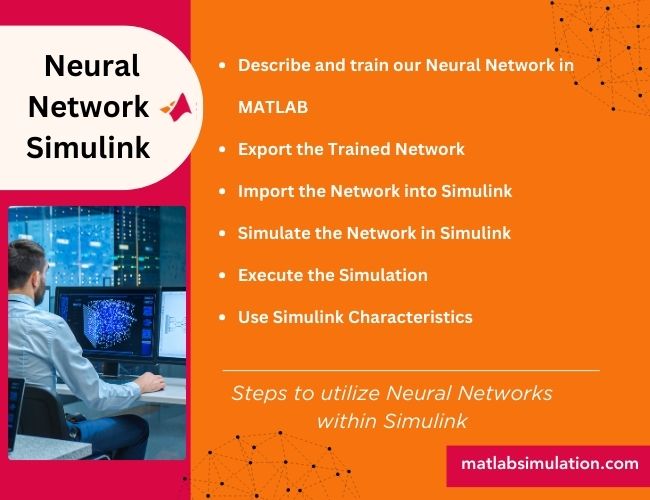For developing and simulating an effective framework, MATLAB Simulink is considered as a robust tool. When Simulink is basically employed for simulation in various fields like signal processing, interactions and control systems, it also combines with MATLAB’s neural network abilities to develop and simulate frameworks that comprise neural networks. We serve as a catalyst in serving you the right Neural Network Simulink topics and writing work. On all disciplines we have experts to guide to make use of our professionals support and set a ground breaking contributions to research field by having matlabsimlation.com by your side.
Below, we describe about the procedural steps to utilize neural networks within Simulink:
Step 1: Describe and Train our Neural Network in MATLAB:
Initially, we describe and train our neural network in MATLAB through the employment of Neural Network Toolbox before introducing it into Simulink. This includes:
- Preprocessing our data
- Selection of proper neural network frameworks like recurrent, feedforward, etc.
- By utilizing functions such as trainNetwork for deep networks, we train the network with our data and use train for shallow networks.
Step 2: Export the Trained Network:
Export our neural network for utilization in Simulink after the training process:
- Our work creates a Simulink framework directly through the employment of gensim functions for shallow neural networks.
- We preserve the trained network and utilize MATLAB Functions blocks to communicate with the networks inside the Simulink for deep networks.
Step 3: Import the Network into Simulink:
Here, our research suggests two choices to import the network into Simulink
- Shallow Networks: In this, Simulink blocks illustrating the neural networks are autonomously generated if we employ gensim.
- Deep Networks: By incorporating the MATLAB Function block, our project imports the network and where we write MATLAB code to compile and execute the network through the use of functions such as load and predict.
Step 4: Simulate the Network in Simulink:
Construct our Simulink framework around network after importing it:
- To feed data into our network, we utilize sources.
- To capture and envision the network’s outcome, sinks are useful for us.
- For preprocessing the data input into the network, we concatenate other blocks as required or carry out the procedure of post-process the outcome of the network.
Step 5: Execute the Simulation:
After creating the Simulink framework, simulate it to interpret how a neural network works within our framework’s environment. As required, we examine the outcome, adjust the framework or retrain the neural network.
Step 6: Use Simulink Characteristics:
Our work considers the merits of different features of Simulink including:
- Tunable Parameters: If our network has parameters, we intend to adjust during simulation and arrange these in MATLAB and employ them inside the Simulink framework.
- Model Referencing: Our project considers other Simulink frameworks inside the major framework and enables us to segment complicated models.
- Coder Products: To generate C / C++ code from the Simulink framework, we employ Embedded Coder or Simulink Coder. For implementation on hardware, neural networks are supportive for us.
Notes:
- Specifically if we aim to execute actual-time simulations or create code for embedded devices, often remember the computational difficulty of our neural network.
- Make sure whether our project contains appropriate toolboxes downloaded like the MATLAB Coder for code generation and MATLAB’s Deep Learning Toolbox for deep neural networks.
- Sometimes complicated neural networks need relevant computing resources that are not adaptable with actual-time simulation or embedded devices without optimization. Therefore, we should be familiar with our hardware’s challenges.
- To interpret particular characteristics, summarization and instances offered by MATWorks are innovative initial points and also provide patterns for neural network fusion in Simulink.
Utilization of neural networks in Simulink enables us to integrate the capacity of MATLAB’s computing abilities with the effective frameworks modeling characteristics of Simulink and allowing advanced simulations that comprise artificial intelligence factors.

Neural Network MATLAB Simulink Projects
Neural Network MATLAB Simulink Projects are exclusively carried out by using trending simulation methods at matlabsimulation.com. On choosing the correct Neural Network MATLAB Simulink topic as per your interest we follow interdisciplinary rules and fill in the existing research gaps. Neural Network MATLAB Simulink Projects will be done by using the correct source code where we handover the appropriate reference will proper explanation.
- Oscillatory neural unit and simultaneous energy-value extraction for Hopfield neural network
- Knowledge Extraction from Neural Networks Using the All-Permutations Fuzzy Rule Base: The LED Display Recognition Problem
- A learning scheme of neural networks which improves accuracy and speed of convergence using redundant and diversified network structures
- Application of neural network in fault location of optical transport network
- Stabilization of flexible structures using artificial neural networks
- Simultaneous perturbation learning rule for recurrent neural networks and its FPGA implementation
- A constant-time neural network for multiple selection
- Comparison of generalized regression neural network and MLP performances on hydrologic data forecasting
- An adaptive data sorter based on probabilistic neural networks
- Compact VLSI neural network circuit with high-capacity dynamic synapses
- Terrain classification in SAR images using principal components analysis and neural networks
- Time sequential pattern transformation and attractors of recurrent neural networks
- Hypersausage Neural Networks and its Application in Face Recognition
- Estimations of error bounds for neural-network function approximators
- Global exponential stability for recurrent neural networks with a general class of activation functions and variable delays
- Dynamical process of learning chaotic time series by neural networks
- Using recurrent multilayer neural network for simulating batch reactors
- Self-improving associative neural network models
- Equivalence between RAM-based neural networks and probabilistic automata
- Acoustic diagnosis for compressor with hybrid neural network












